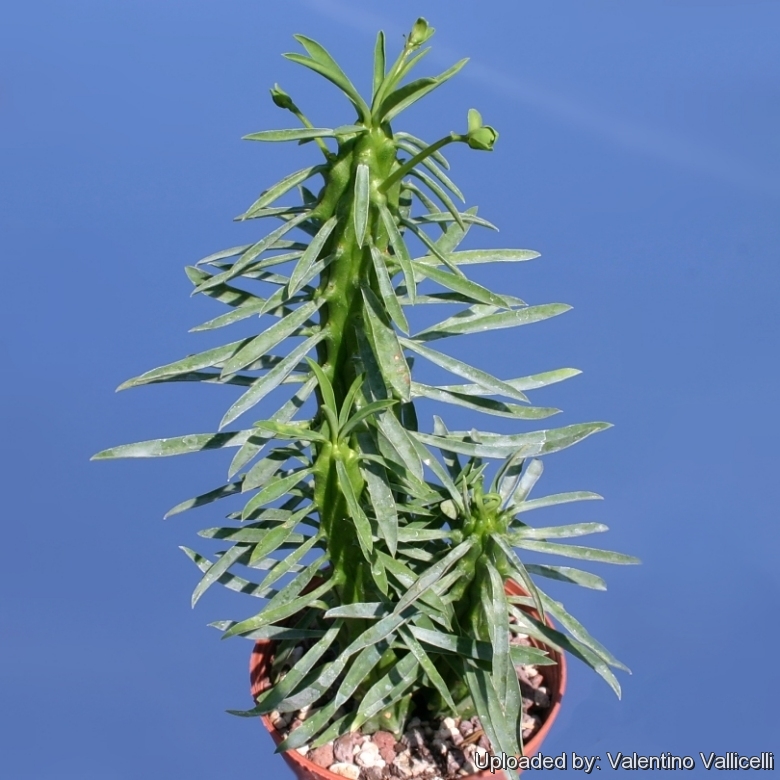
Euphorbia clava Photo by: Valentino Vallicelli
This species forms erect club-shaped leafed stems with hexagonal tubercles in rows.
Origin and Habitat: East Cape endemic (from Humansdorp to King William's Town), South Africa
Synonyms:
See all synonyms of Euphorbia clava
back
Accepted name in llifle Database:Euphorbia clava Jacq.Icon. Pl. Rar. [Jacquin] 1: 9 t. 85; Coll. 1784 (Coll. 1: 104.)Synonymy: 5
back
Common Names include:
ENGLISH: Club Spurge
Description: Succulent shrublet 60 to 1.5 m tall producing a dense cluster. Characteristically club-shaped when young.
Stem: Cylindrical, deep green, erect, simple and ribbed, with hexagonal tubercles to 6 mm long and 1-1.5 cm wide at base. Branchlets club-shaped.
Spines: Spineless.
Leaves: Bright green to glaucous green, linear, with the edges parallel and long lasting.
Flowers: Very pretty, and ample, long peduncled, cyathia with light-green to purplish bracts.
Blooming season: Late winter to spring.
Fruits: Once the pod dries, it will dehisce and catapult it's seeds a surprising distance.
Bibliography: Major references and further lectures
1) Urs Eggli “Illustrated Handbook of Succulent Plants: Dicotyledons” Springer, 2002
2) Hermann Jacobsen “A handbook of succulent plalnts: Abromeitiella to Euphorbia” Blandford Press, 1960
3) James Cullen, Sabina G. Knees, H. Suzanne Cubey “The European Garden Flora Flowering Plants: A Manual for the Identification of Plants Cultivated in Europe, Both Out-of-Doors and Under Glass” Cambridge University Press, 11/ago/2011
4) Doreen Court “Succulent Flora of Southern Africa” CRC Press, 01/giu/2000
5) Alain Campbell White, Robert Allen Dyer, Boyd L. Sloane “The succelent Euphorbisae (southern Africa)” Abbey garden press, 1941
6) Werner Rauh “Cultivation and Description of Selected Succulent Plants Other Than Cacti” Smithsonian Institution Press 1984
7) Gibbs Russell, G. E., W. G. Welman, E. Reitief, K. L. Immelman, G. Germishuizen, B. J. Pienaar, M. v. Wyk & A. Nicholas. “List of species of southern African plants.” Mem. Bot. Surv. S. Africa 2(1–2): 1–152(pt. 1), 1–270(pt. 2). 1987.
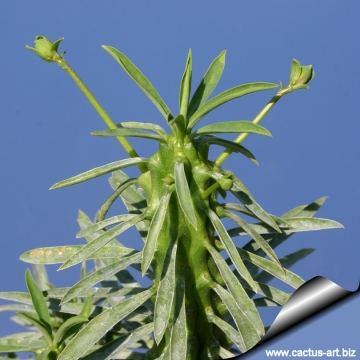 Euphorbia clava Photo by: Cactus Art
Euphorbia clava Photo by: Cactus Art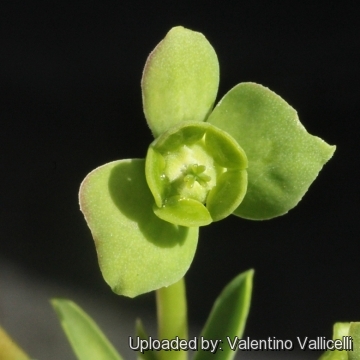 Euphorbia clava Photo by: Valentino Vallicelli
Euphorbia clava Photo by: Valentino Vallicelli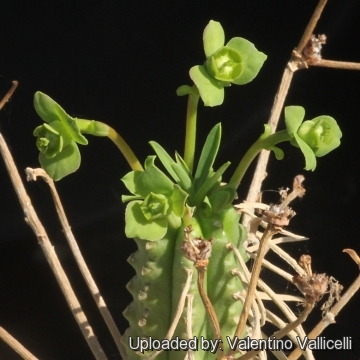 Euphorbia clava Photo by: Valentino Vallicelli
Euphorbia clava Photo by: Valentino Vallicelli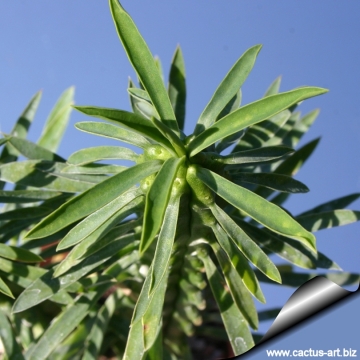 Euphorbia clava Photo by: Cactus Art
Euphorbia clava Photo by: Cactus Art Euphorbia clava Photo by: Valentino Vallicelli
Euphorbia clava Photo by: Valentino VallicelliSend a photo of this plant.The gallery now contains thousands of pictures, however it is possible to do even more. We are, of course, seeking photos of species not yet shown in the gallery but not only that, we are also looking for better pictures than those already present.
Read More... Cultivation and Propagation: It is an easy species to grow that is suited for any well drained soil in full sun. But young plant are happy growing indoors, where they can easily reach the ceiling. Give the plant an airy growing medium which mainly consists of non organic material such us clay, pumice, lava grit, and only a little peat or leaf-mould. Water regularly during the active growing season from March to September. No water should ever be allowed to stand around the roots. Keep almost completely dry in winter. It is a moderately fast grower, and will quickly become large landscape masterpieces in just 3-5 years. Only downside is from strong winds, the columns often smash into each other, causing permanent scarring... best to plant in such a location where winds are not a big issue. If plant becomes very red, this is a sign that the roots have not developed properly. It is a relatively fast growing and long lived plant and once established, it will be content in its position and with its soil for years. It can tolerate moderate shade, and a plant that has been growing in shade should be slowly hardened off before placing it in full sun as the plant will be severely scorched if moved too suddenly from shade into sun. Like quite small pots, repott in very later winter, early spring. Can be pruned for shape and branching. Frost tender, frost free zones only. Plant Pests: Prone to mealy bugs and rarely scale.
Propagation: It is easy to propagate by cuttings in late spring to summer, just take a cutting of the plant let it dry for 1 or 2 weeks and stuff it in the ground (preferably dry, loose, extremely well draining soil).
Warning: All Euphorbias contain a white sap that can be irritating to eyes and mucous membranes. If contact is made with this white sap, take care to not touch face or eyes before washing hands with soap and water.
















